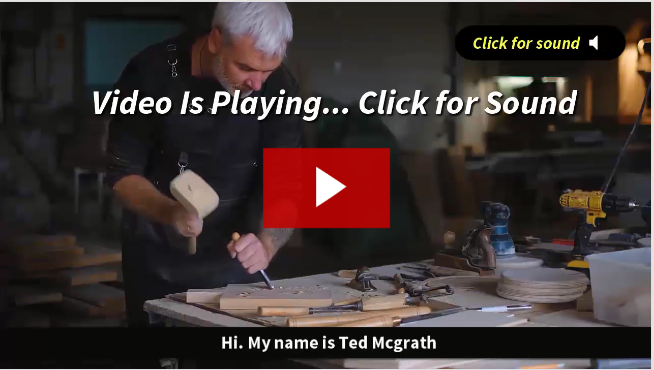Types of Woodworking Joints: A Complete Guide
Every woodworking project—big or small—depends on one critical element: the joints that hold it all together. From simple butt joints to precision dovetails, each type of woodworking joint offers its own strength, purpose, and level of skill. Choosing the right joint isn’t just a technical decision; it determines the durability, appearance, and overall quality of your finished piece. But with so many joint styles available, understanding when and how to use each one can feel overwhelming.
In this complete guide to the types of woodworking joints, we’ll break down the most common (and most essential) joints, how they work, where they’re used, and the advantages each one offers. Whether you’re a beginner learning the basics or an experienced woodworker refining your craft, this guide will help you build stronger, cleaner, and more reliable projects every time.

👉 CLICK HERE to Unlock 16,000+ DIY woodworking plans now
Why Woodworking Joints Matter
Woodworking isn’t just about cutting and sanding — it’s about how pieces come together. A project with strong, well-chosen joints will last for decades. A poorly joined piece? It may fall apart the moment you put weight on it.
The right joint depends on the:
- Purpose of your project
- Type of wood
- Load/stress it will bear
- Whether appearance or strength matters more
Knowing when and how to use each type of joint separates beginners from true craftsmen — and that’s where this guide comes in.
👉 CLICK HERE to Unlock 16,000+ DIY woodworking plans now
1. Butt Joint — Simple, but Not Always Strong
The butt joint is the most basic woodworking joint. One piece of wood is butted up against another and fastened with glue, nails, or screws.
Best For: Simple frames, beginner projects, temporary builds
Pros: Quick, easy, no complex cuts
Cons: Not strong on its own — needs reinforcements
Pro Tip: Reinforce butt joints with dowels, biscuits, or corner brackets to improve durability.
2. Miter Joint — Perfect for Picture Frames
A miter joint is like a fancy butt joint where the ends of the wood are cut at 45° angles and joined to form a corner.
Best For: Picture frames, trim, decorative corners
Pros: Visually clean, hides end grain
Cons: Weak without reinforcement
Want perfect miter joints? Ted’s Woodworking shows exactly how to cut and clamp them with precision — no expensive tools needed.
3. Dado Joint — Secure for Shelves and Cabinets
The dado joint is a groove cut into one board where another board fits snugly. Think of bookshelves — the shelves usually sit in dado joints.
Best For: Bookshelves, cabinet interiors, drawer dividers
Pros: Very strong, hides fasteners
Cons: Requires accurate groove-cutting
Bonus: Pair dados with glue and clamps, and you’ll have rock-solid construction.
4. Rabbet Joint — The Go-To for Drawer Backs
A rabbet joint involves a notch cut along the edge or end of a board, allowing another piece to fit in like a puzzle.
Best For: Drawer construction, cabinet backs, box corners
Pros: Offers strength and clean fit
Cons: Visible from the outside unless covered
Ted’s Tip: Add a backer board when cutting rabbets with a table saw to reduce tear-out and get cleaner edges.
5. Lap Joint — Simple but Strong
In a lap joint, two boards overlap — either fully (full lap) or halfway (half-lap). This increases surface area for glue, making it strong and stable.
Best For: Framing, doors, workbenches
Pros: Strong and easy to align
Cons: Reduces board thickness
Ideal for beginners learning joinery without complex tools.
🛠️ Ted’s 16,000 Woodworking Plans – Why You’ll Love It


6. Mortise and Tenon Joint — A Woodworking Classic
This is one of the oldest and strongest joints in woodworking. A tenon (tongue) is cut on one board and fits tightly into a mortise (hole) in another.
Best For: Chairs, tables, beds — any load-bearing structure
Pros: Extremely durable and traditional
Cons: Requires precise cutting
Want to master this joint? Ted’s Woodworking provides step-by-step plans using both hand tools and power tools.
7. Dovetail Joint — Strong and Beautiful
A dovetail joint looks like interlocking fingers. It’s a favorite among woodworkers for both its strength and beauty.
Best For: Drawers, jewelry boxes, fine furniture
Pros: Nearly impossible to pull apart, no nails needed
Cons: Time-consuming and challenging for beginners
Ted’s secret: Use his jigs and templates to cut dovetails easily — no guesswork, just results.
8. Pocket Hole Joint — Hidden Strength
Pocket holes are angled holes drilled into one board so screws can join it to another board discreetly.
Best For: Cabinets, face frames, quick furniture builds
Pros: Fast, strong, and hidden from view
Cons: Requires a pocket hole jig
Fast-track your furniture builds with Ted’s pocket hole tips — especially great for DIYers in small spaces.
9. Biscuit Joint — Invisible & Precise
This joint involves a football-shaped piece of compressed wood (a “biscuit”) inserted into slots cut into two boards. Once glued, it expands and bonds the boards.
Best For: Tabletops, edge joining, panels
Pros: Invisible joint, strong alignment
Cons: Requires a biscuit joiner
Ted’s Woodworking Bonus: Find creative biscuit joinery uses in dozens of plans — including modern tabletops and farmhouse builds.
10. Finger Joint (Box Joint) — Box Building Made Easy
Similar to a dovetail, the finger joint uses square fingers that interlock. It’s easier to cut and ideal for making boxes.
Best For: Boxes, drawers, small containers
Pros: Strong and attractive
Cons: Visible unless concealed
Pro Finish Tip: Sand lightly and apply finish to highlight the joint pattern — looks great with contrasting woods.
Choosing the Right Joint for Your Project
| Joint Type | Best For | Skill Level | Tools Needed |
|---|---|---|---|
| Butt | Beginner builds | Beginner | Saw, glue, screws |
| Dovetail | Drawers, heirlooms | Advanced | Dovetail saw, chisels |
| Mortise & Tenon | Furniture | Intermediate/Advanced | Chisels, mallet |
| Pocket Hole | Fast assembly | Beginner/Intermediate | Pocket hole jig |
| Lap Joint | Frames | Beginner | Saw, chisel |
| Biscuit | Panels | Intermediate | Biscuit joiner |
| Miter | Frames, trim | Beginner | Miter saw |
| Dado/Rabbet | Cabinets | Intermediate | Router or table saw |
| Finger Joint | Boxes | Intermediate | Dado blade, jig |
The Easy Way to Learn All These Joints: Ted’s Woodworking
Trying to learn joints by watching scattered YouTube videos or experimenting blindly? That’s a recipe for frustration.
Ted’s Woodworking gives you:
✅ 16,000+ step-by-step woodworking plans — many with multiple joint types
✅ Clear diagrams and blueprints — no technical jargon
✅ Cut lists, material guides, tool tips — save money and time
✅ Plans for ALL skill levels — from complete beginner to advanced craftsman
Whether you’re making a dresser with dovetails or a shoe rack with dados, Ted’s plans walk you through every step like a personal mentor.
👉 CLICK HERE to Unlock 16,000+ DIY woodworking plans now
Final Thoughts
The joints you choose determine the strength, durability, and beauty of your woodworking project. While some are simple and perfect for quick builds, others like dovetail and mortise & tenon offer unmatched strength and craftsmanship.
And the best part? You don’t have to figure it all out alone.
With Ted’s Woodworking, you can master every joint, build professional-quality projects, and grow your skills faster than you ever thought possible.
🔨 Ready to Join the Pros?
Download your 16,000+ Ted’s Woodworking plans today and transform your weekend projects into lifetime masterpieces.
👉 CLICK HERE to Unlock 16,000+ DIY woodworking plans now
